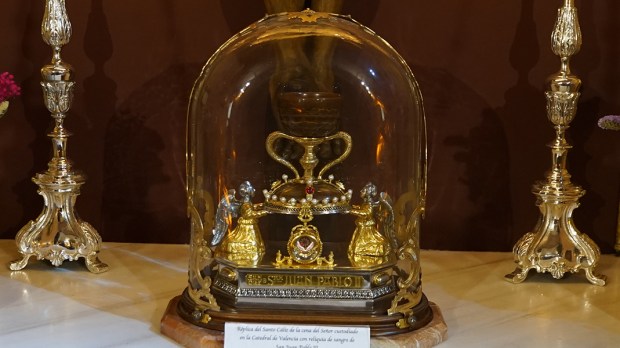Would you like to gain fame and fortune? Would you like to sell lots of books and movies? Have a permanent place in social media? Maybe earn a doctorate or two in a wide variety of disciplines? Then these two words should be on your lips: “Holy Grail.”
The Holy Grail has captured the imagination for centuries, inspiring artisans working in every medium. Poetry, sculpture, painting, story, song—even the disciplines of architecture, geography and geology have featured in the apparently never-ending progression of the legend(s) of the Holy Grail.
But what’s the real story behind it all?
And might that not be the wrong—or at least not the most important—question to ask?
All these things and more were on my mind as I finished reading A Catholic Quest for the Holy Grail by scholar, author and raconteur Charles A. Coulombe. I had the good fortune of interviewing him recently about his book. You can find the audio of that interview, along with a resources list, HERE. (A link to the interview as a downloadable file can be found HERE.)
Coulombe starts his book with a recognition of how old, multi-faceted, and still growing the topic is:
The Holy Grail! What a strange and alluring kaleidoscope of images and thoughts gather about those two words! From King Arthur to Monty Python, from T.S. Eliot to Richard Wagner, every era since at least the 1100s has produced stories, songs and images centering upon this mysterious theme. Once the object of chivalric quests and holy pilgrimages, it has become in recent years the sacred totem of several esoteric and New Age movements. But what was it really? Does it have any significance for twenty-first century Catholics?
Regarding, “… what was it really?,” he supplies a well-constructed montage of legends accrued over the centuries.
It is reputed to be the chalice that Our Lord used at the Last Supper. Some legends say it was also used to catch the Precious Blood that flowed from the pierced Sacred Heart at Calvary.
Coulombe also offers a case (backed by, among other things, some recent scholarship found HERE) that the Holy Grail (regardless of its putative meanderings all over the Holy Land and Europe) is now to be found in the Cathedral of Valencia, Spain.
But does that matter?
The charm and value of Coulombe’s book, in particular, I believe, is to be found in his treatment of the latter question: “Does it have any significance for twenty-first century Catholics?”
A true romantic, he addresses the question in the book’s last chapter: “The Quest Fulfilled … and Begun Anew.” The Holy Grail is not just an object or a legend or a bit of whimsy. For faithful Catholics who see that the absolutely decisive moment of human history is the bloody sacrifice of the Christ of God on Calvary, a sacrifice made present again in an unbloody way on the altar during the Holy Sacrifice of the Mass, the Holy Grail and all that it represents makes demands upon us.
It calls, as he says, for a “re-enchantment” of our senses and our souls, to see beauty where beauty appears to be obscured, to love when love seems impossible, and to find a path to victory and glory by the via dolorosa of suffering and death:
What in the end, is the Holy Grail? It is many things; but above all, it symbolizes in itself all in our Faith that is miraculous, sacramental, devotional, royal and chivalric—that is to say, all that element of the Catholic religion that appears otherworldly but in fact is beyond the power of the cleric or layman to make or mar, that survives, unchanged and unchanging, through war and famine, heresy and schism. True evangelization is carried out by those who are imbued with its spirit, regardless of whether or not they know it by that name.
Life without all that the Holy Grail represents is flat, colorless, and unable to sustain, much less reward hope. Such life could be summed up by these words of philosopher Thomas Nagel: “We are an episode between two oblivions.”
How very different from a soul animated by the Eucharistic glories represented by the Holy Grail. That life can be summed up by St. Therese of Lisieux: “Let us see life as it really is … a moment between two eternities.”
Find your favorite accounts and depictions of the Holy Grail. Consider the generosity that chivalry and pilgrimage have—at their best—always called for. Then read the last five chapters of each of the Gospels.
Finally, go spend an hour before the Blessed Sacrament, and let the Lord of the Holy Grail summon you to His Service.
When I write next, I will about speak how to get ready for the apocalypse with this one neat trick! Until then, let’s keep each other in prayer.

Read more:
‘He made straight for the relics’: Firefighter chaplain saves Crown of Thorns

